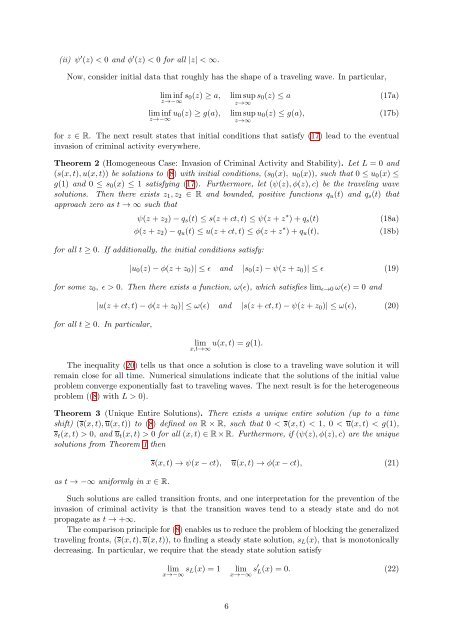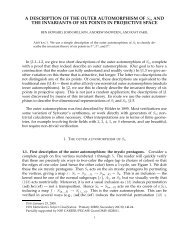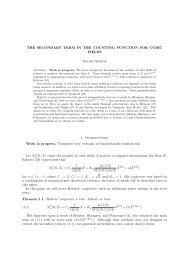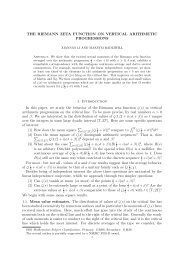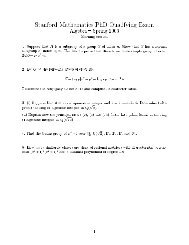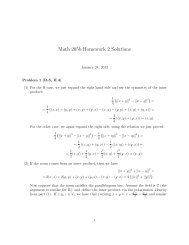Traveling Wave Solutions in a Reaction-Diffusion Model for Criminal ...
Traveling Wave Solutions in a Reaction-Diffusion Model for Criminal ...
Traveling Wave Solutions in a Reaction-Diffusion Model for Criminal ...
You also want an ePaper? Increase the reach of your titles
YUMPU automatically turns print PDFs into web optimized ePapers that Google loves.
(ii) ψ ′ (z) < 0 and φ ′ (z) < 0 <strong>for</strong> all |z| < ∞.<br />
Now, consider <strong>in</strong>itial data that roughly has the shape of a travel<strong>in</strong>g wave. In particular,<br />
lim <strong>in</strong>f<br />
z→−∞ s0(z) ≥ a, lim sup s0(z) ≤ a (17a)<br />
z→∞<br />
lim <strong>in</strong>f<br />
z→−∞ u0(z) ≥ g(a), lim sup u0(z) ≤ g(a), (17b)<br />
<strong>for</strong> z ∈ R. The next result states that <strong>in</strong>itial conditions that satisfy (17) lead to the eventual<br />
<strong>in</strong>vasion of crim<strong>in</strong>al activity everywhere.<br />
Theorem 2 (Homogeneous Case: Invasion of Crim<strong>in</strong>al Activity and Stability). Let L = 0 and<br />
(s(x, t), u(x, t)) be solutions to (8) with <strong>in</strong>itial conditions, (s0(x), u0(x)), such that 0 ≤ u0(x) ≤<br />
g(1) and 0 ≤ s0(x) ≤ 1 satisfy<strong>in</strong>g (17). Furthermore, let (ψ(z), φ(z), c) be the travel<strong>in</strong>g wave<br />
solutions. Then there exists z1, z2 ∈ R and bounded, positive functions qu(t) and qs(t) that<br />
approach zero as t → ∞ such that<br />
z→∞<br />
ψ(z + z2) − qs(t) ≤ s(z + ct, t) ≤ ψ(z + z ∗ ) + qs(t) (18a)<br />
φ(z + z2) − qu(t) ≤ u(z + ct, t) ≤ φ(z + z ∗ ) + qu(t), (18b)<br />
<strong>for</strong> all t ≥ 0. If additionally, the <strong>in</strong>itial conditions satisfy:<br />
|u0(z) − φ(z + z0)| ≤ ɛ and |s0(z) − ψ(z + z0)| ≤ ɛ (19)<br />
<strong>for</strong> some z0, ɛ > 0. Then there exists a function, ω(ɛ), which satisfies limɛ→0 ω(ɛ) = 0 and<br />
|u(z + ct, t) − φ(z + z0)| ≤ ω(ɛ) and |s(z + ct, t) − ψ(z + z0)| ≤ ω(ɛ), (20)<br />
<strong>for</strong> all t ≥ 0. In particular,<br />
lim u(x, t) = g(1).<br />
x,t→∞<br />
The <strong>in</strong>equality (20) tells us that once a solution is close to a travel<strong>in</strong>g wave solution it will<br />
rema<strong>in</strong> close <strong>for</strong> all time. Numerical simulations <strong>in</strong>dicate that the solutions of the <strong>in</strong>itial value<br />
problem converge exponentially fast to travel<strong>in</strong>g waves. The next result is <strong>for</strong> the heterogeneous<br />
problem ((8) with L > 0).<br />
Theorem 3 (Unique Entire <strong>Solutions</strong>). There exists a unique entire solution (up to a time<br />
shift) (s(x, t), u(x, t)) to (8) def<strong>in</strong>ed on R × R, such that 0 < s(x, t) < 1, 0 < u(x, t) < g(1),<br />
st(x, t) > 0, and ut(x, t) > 0 <strong>for</strong> all (x, t) ∈ R × R. Furthermore, if (ψ(z), φ(z), c) are the unique<br />
solutions from Theorem 1 then<br />
as t → −∞ uni<strong>for</strong>mly <strong>in</strong> x ∈ R.<br />
s(x, t) → ψ(x − ct), u(x, t) → φ(x − ct), (21)<br />
Such solutions are called transition fronts, and one <strong>in</strong>terpretation <strong>for</strong> the prevention of the<br />
<strong>in</strong>vasion of crim<strong>in</strong>al activity is that the transition waves tend to a steady state and do not<br />
propagate as t → +∞.<br />
The comparison pr<strong>in</strong>ciple <strong>for</strong> (8) enables us to reduce the problem of block<strong>in</strong>g the generalized<br />
travel<strong>in</strong>g fronts, (s(x, t), u(x, t)), to f<strong>in</strong>d<strong>in</strong>g a steady state solution, sL(x), that is monotonically<br />
decreas<strong>in</strong>g. In particular, we require that the steady state solution satisfy<br />
lim<br />
x→−∞ sL(x) = 1 lim<br />
x→−∞ s′ L(x) = 0. (22)<br />
6


